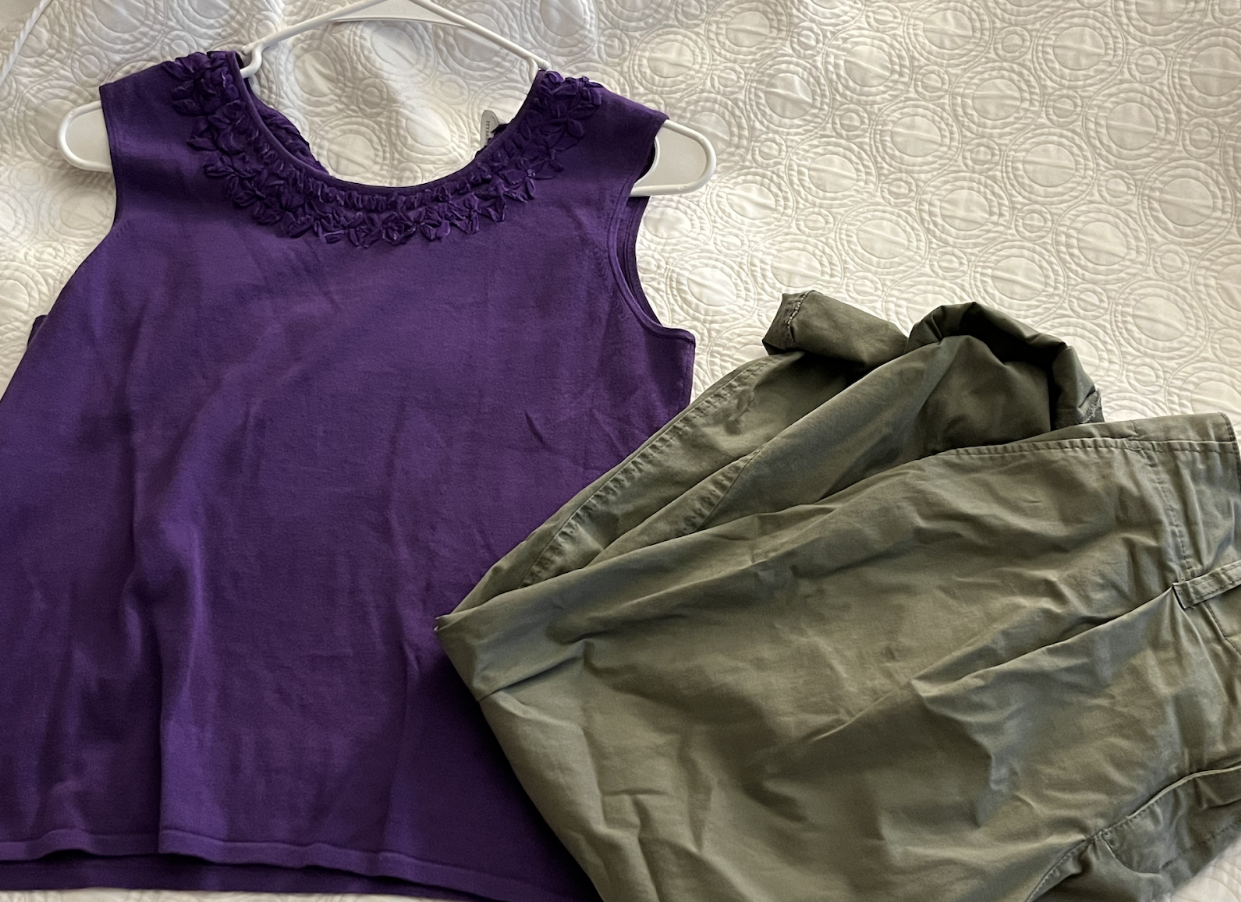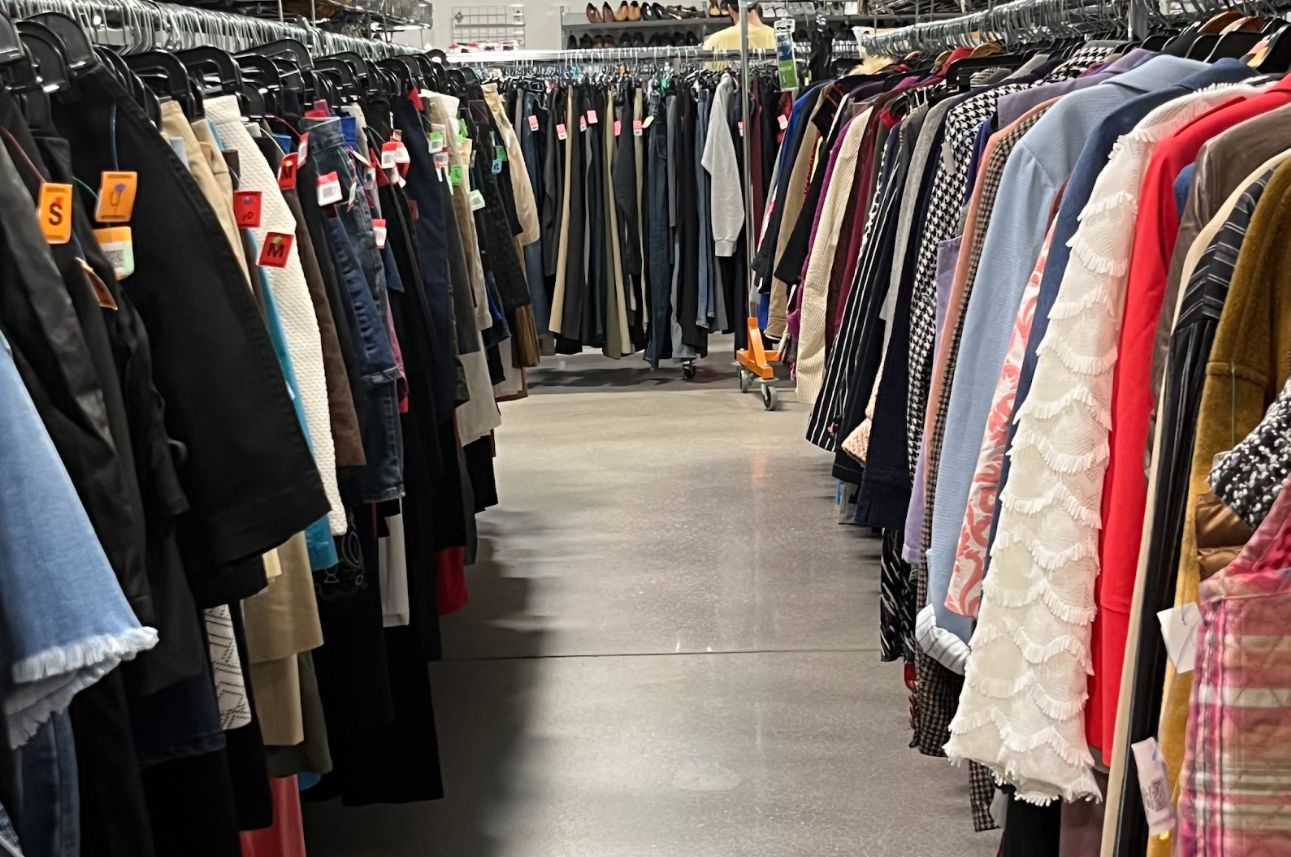Once a year, plastic packages that will most likely end up sitting in landfills fly off the shelves to enhance a scary ensemble. According to Earth.Org, 20 percent of water waste is a byproduct of the fast fashion industry and Halloween only exacerbates this statistic. During the months of October to December, the average waste increases by 25 percent as opposed to any other time of year. Halloween is one of the worst textile waste offenders because people buy costumes they will only wear once or twice. According to Environment America, textile waste is the second worst polluter, responsible for ten percent of the world’s global carbon emissions. Social media encourages this waste, with costume trends coming and going every Halloween season. People who bought their costumes prior to an invite to a themed party or a new trend of costumes now scramble to order another outfit.
For this upcoming Halloween, the trends of thrifting, repurposing and environmentally ethical consumption should receive more attention. Thrifting helps to alleviate clothing waste that would end upin landfills, emitting greenhouse gasses and carbon emissions during the decomposition process. Corporations responsible for carbon emissions and water waste should not have to manufacture as many clothes when more people are purchasing repurposed clothing.
Thrifting when looking for something specific, such as for a costume piece, can be an arduous task, however. The Catalyst asked around and found a range of useful hacks.
Second-year and thrifting connoisseur Lainey Rose provided her best advice for beginners. “I would say my go-to thrifting advice is to start off simple. Of course, it is always good to check out tank tops, t-shirts, jeans and pants. But some of my favorites places to look are in the lingerie/pajama section for slip dresses or silk tops, the men’s section for oversized shirts or jackets and the kids section for baby tees and little boy’s jeans. Sometimes all the clothes can be really overwhelming, so creating something like a Pinterest board always helps me find the specific items I am looking for, or at least something similar.”
Rose has thrifted and made Halloween costumes by hand since she was a little girl. Homemade costumes offer a unique and creative look, as well as the experience of making the costume and sifting through racks to find certain pieces. She also advises that a pair of scissors or a simple stitch can make something old into something new.
“Thrifting a costume is honestly easier than it sounds,” Rose said. “You can always look up inspiration for costumes and then find similar colored or styled pieces. I have found that purchasing an accessory that makes the costume more [easily recognized], and then just thrifting certain colors for the rest of the outfit. Some of my favorites of this combination include any animal, a carrot or a cartoon character.”
Focusing on color schemes, as Rose suggested, is an easy way to create a costume—for example, dressing up as Daphne from the cartoon Scooby Doo, who is known for her green and purple attire. One can wear her colors in a stylish, recognizable and reusable Halloween costume. Then the items can be separated for everyday use.

First-year Ellary Combs shared her experience with thrifting Halloween costumes and her favorite part of the process. “There’s a lot of football games where I do themed stuff, like ‘pink out’ or Halloween costumes. I did Raven and Beast Boy [from Teen Titans] one year. I got a black bodysuit and sewed on feathers. Then I think I ended up cutting it into a tank top and I’ve worn it a couple times. I like that thrifting is very unique and personalized. You can go and you can find stuff that you wouldn’t find in H&M or Forever 21 or someplace like that.”
Second-year Anna Lazzara shared her go-to thrifting advice. “Plan to spend a lot of time in the thrift store, at least an hour and a half. Give yourself plenty of time to sift through all the racks. Many thrift stores are organized by size, color and type of clothing, so start looking in the section of clothing you want, and also in your size and desired color. My favorite part of thrifting is checking out. I love seeing such a low price! It’s amazing how many things you can buy for a fraction of the price at a retail store.”
Third-year Safari Swanson recalled the origins for his love of thrifting. “I grew up pretty impoverished in New Jersey. Originally, as a child, I would be stuck buying just like, two or three garments from really cheap manufacturers like Walmart or Target. My older brother, Eric, who’s 13 years older than me, got really into thrifting and reselling. And then, I remember I totally changed my whole wardrobe. Instead of getting two pairs of pants for the year at Walmart, I can just use the money and get 14 pairs of pants at Goodwill. And it’s so much more colorful, and there’s many more options. It was really just an accessible thing to me when I was younger.”
Swanson mentioned how thrifting has become extremely popular for members of Generation Z, which is great for the environment. However, finding things in thrift stores has become more competitive. Swanson offered a solution to scoping out specific pieces.
“I would just say thrift consistently, whether it’s Sunshine [Thrift] or Goodwill or whatever [place] you like, going consistently knowing that you’re not going to get something you like every time, but you’re going to be able to build your wardrobe.”
Swanson recommends Sunshine Thrift in Bradenton as a great spot for finding pieces. He also recommends online thrifting platforms.
Swanson told the Catalyst that he and his partner are planning on thrifting and upcycling their couple costumes this year. “I think utilizing online platforms is a really good way to supplement things. The thrift [stores] are good for finding general garments. If you’re on a time crunch, something like eBay or Depop has good prices, but especially eBay [where] you can find whatever garment you want and in whatever color and in whatever size.”
Furthermore, plastic Halloween decorations that end up thrown away or sitting in attics for eternity can be upcycled instead. One can take a white sheet, stuff an end with other clothes, and tie a rubber band around the “head” to make an environmentally friendly ghost decoration. One can also turn a past-its-prime carved pumpkin into pumpkin pie, soup or even compost for those who may lack cooking abilities. Roasted pumpkin seeds are high in protein and the perfect lazy snack. Simply sprinkle some salt or any seasoning to one’s liking and give the seeds a long and slow death by oven. Mason jars with colored lights can be used for every holiday simply by changing the color of the fairy lights.
Equipment Teaching Assistant (EQTA) Alex “Fish” Sauer has been thrifting since they were 14 and offered suggestions for first-time thrifters and how to negotiate prices. “Set a budget first,” Sauer stated. “If you set a budget, then you have a place to negotiate from if you have to. And it sounds really silly, but if you set the budget, it’s easier for you to decide on when you go to the market, whether that’s at a flea market, or a trade expo or anything, you can then prioritize the most important things for you to pick up that day.”
Sauer enjoys picking up small items for friends and loved ones. Sauer’s family is from New Orleans and they explained the words “lagniappe” and “sussy” meaning “something extra.” Sauer uses the terms when bringing back second-hand gifts for their friends. They are also an upcycler and enjoy taking second-hand curtains or tapestries and turning them into a new outfit.
“The first project that I did was during Covid,” Sauer recounted. “I found some curtain material and it’s a crushed velvet and they’re bright gold and I started walking casually at night on campus with it because they’re just really comfy, but I created a pair of really long flowy golden pants out of this curtain material. And so now at the end of Center of the Universe Parties (COUPs), if you see the golden pants, it’s probably time to go. ”
COUPs are themed, campus-wide parties that happen three times over the course of the academic year. This year’s Halloween theme, voted on and created by students, is “Haunted Carnival.” Possible costume ideas can be clowns, fortune tellers or magicians. For a fortune teller, one can take a dark, long dress and scarf around their head, and add some chunky jewelry. A magician can wear a black vest and other black clothing they might already own, like cut-up dress pants or a suit jacket (a couple costume could have someone as a bunny rabbit). A clown, friend or foe, is dependent on makeup and one can wear bright mismatched colors from their wardrobe. These ideas are environmentally friendly and require minimal purchases.
There is an intersection between festivity and practicing ethical consumerism; the two are not mutually exclusive. Using creativity adds new dimensions to the excitement of costumes and decorations while not adding to the tons of waste in the oceans and landfills. The spookiness of this holiday season should not come from new climate change statistics.

